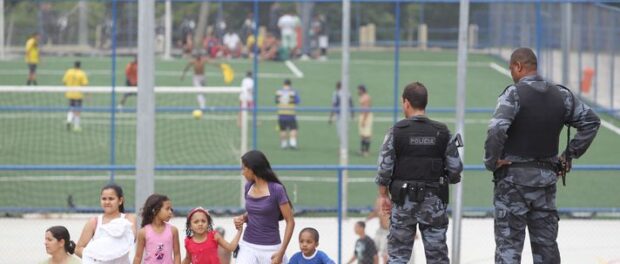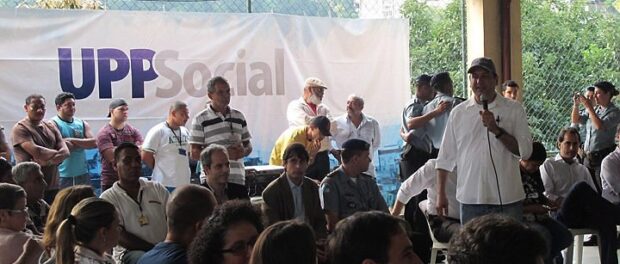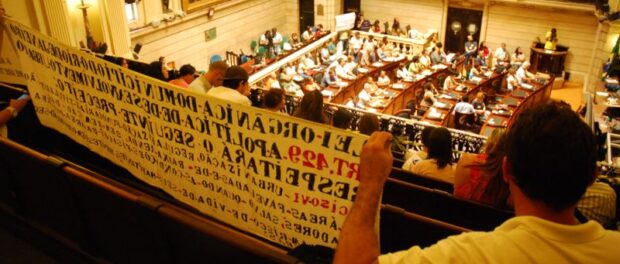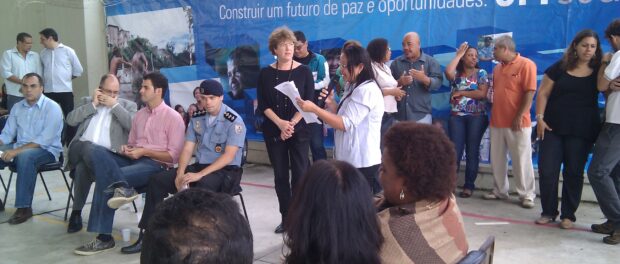
On July 23rd of last year, Eduarda La Rocque, president of the IPP–Instituto Pereira Passos, Rio’s city planning agency–was invited by the NGO Move Rio to give a talk on “The social, economic and urban integration of the city of Rio de Janeiro.” In the elegant lounge of the Amsterdam Sauer jewelry store in Ipanema, La Rocque presented the UPP Social program coordinated by herself and the IPP.
At the event, La Rocque insisted on the program’s importance as a catalyst for change and integration in a city marred by deep socio-spatial inequalities. The presentation depicted a successful, effective, international award-winning program bent on revolutionizing the way public policies are designed and carried out.
The UPP Social program has since been rebranded as the Rio+Social program, however, in order to “supercede the stigma” associated with the program and due to the need to “disassociate public policy actions from those related to security in the favelas occupied by police forces.”
Before allowing the original program to pass in our collective memory, however, it is important to stop and reflect. Did UPP Social really represent a genuine attempt to modernize the policy-making process and erase the boundaries that divide the city of Rio de Janeiro? Or more of the same? This article’s purpose is to summarize La Rocque’s assertions and put the program in perspective, offering a post-mortem analysis of the UPP Social program, especially through the lens of community participation, in the hopes of securing better results from Rio+Social and the countless other present and future public programs constantly being announced for Rio’s favelas, unfortunately often with similar results.
Introduction to UPP Social
Originally a program launched by the State of Rio de Janeiro in 2010 but transferred to Rio de Janeiro’s city government in 2011, UPP Social aimed to produce quality information about the needs of favelas where the State Military Police has brought security services via its Pacifying Police Units (UPP) program, articulating improvements to missing or low quality public services beyond security to reach these areas, including sanitation (sewerage and waste collection), education, health care, and more.
Under the supervision of the Instituto Pereira Passos (IPP), a city planning agency subordinated to the city’s Casa Civil, UPP Social sought, from 2011-2014, to liaise between the government and pacified communities. As IPP president Eduarda La Rocque explained during the July debate, it focused on knowledge management: “the use of information to promote transformation.”
Reflecting a shift that has occurred in the past couple of decades in Brazil where public security policies and social policies have been increasingly inter-connected, the “pacification” policy was seen to closely link public safety with themes of citizenship, social programs and community actions. Once the community was “pacified” and a permanent police presence installed, the UPP Social team would come in and map the community’s needs in an effort to “match supply with demand,” as La Rocque explained. Designed to complement the UPP program, its primary objective was to “strengthen the territorial control and pacification of the areas with UPPs.”
“Integration” was the key word of UPP Social’s mission as presented by La Rocque: favelas must be integrated to the asfalto (“asphalt,” or “formal” city), which includes everything from defining street names and quite literally putting these communities on the map, to raising socio-economic indicators to those of the “formal” city, erasing the historic gap between the two. To achieve that, actions would be integrated: the various programs and projects carried out by the federal, state and municipal governments, NGOs and the private sector would need to be coordinated and articulated to achieve maximum efficiency and impact, and avoid overlaps and discontinuities.
Participation under tutelage in democratic Brazil, 1988-present
Community participation, though not particularly emphasized in La Rocque’s discourse, was never absent from her rhetoric: “Nothing comes from the top-down, imposed… It has to be built together,” she said. Recognized as a fundamental bedrock for social integration, participation ranks high in the modern development discourse promoted by multilateral agencies such as the United Nations: “A society for all must be equipped with appropriate mechanisms that enable their citizens to participate in the decision-making processes that affect their lives, and ultimately shape their common future.” In Brazil, governments at all levels–federal, state, municipal and regional–have established rules for engaging civil society in participating in policy-making processes, especially at the local level.
The key question then becomes: what kind of participation are we talking about? And: does said “participation” actually influence outcomes? Indeed, from “manipulation” to “citizen control,” from “nonparticipation” to “citizen power,” the meaning and substance of participation varies greatly. As Sherry Arnstein wrote in 1969: “there is a critical difference between going through the empty ritual of participation and having the real power needed to affect the outcome of the process.”
Despite its unquestionable modernity, Rio’s society remains uncompromisingly vertical and hierarchical. The immense and seemingly eternal gap between the affluent and the “have-nots” and the associated fears of explosion of violence have historically encouraged the ruling sectors to establish mechanisms of controlled integration, if integration happens at all, carefully avoiding anything that could affect the verticality of social relations. Broad and effective popular participation is, more often than not, seen as a threat rather than a goal. Since at least the 1930s and the presidency of Getulio Vargas, the Brazilian state apparatus has a long tradition of organizing and supervising the lower classes (see ‘non-participation’), establishing what scholar Alain Rouquié calls “mechanisms of non-coercive demobilization” intended to prevent their spontaneous and autonomous organization and, subsequently, upward mobility.
In the same vein, scholars Frederico Costa and Augusto Cunha describe post-1988 Brazilian participatory institutions as a “direct democracy under tutelage”: “The State… is responsible for establishing which are the acceptable paths of civic participation, who should participate, how that participation must take place and which results this participation must bring about.”
UPP Social and the discourse of civic participation
So where did UPP Social stand within this context? Elsewhere in Brazil, participatory institutions like councils, participatory budgeting, and collectively developed city plans have multiplied since the democratization process resumed with the 1988 Constitution, especially at the local level, reflecting a growing association between civic participation and public policy.
In Rio the shift in discourse to contemplate participation was reflected in the post-1988 favela upgrading program Favela-Bairro and more recently in the unfulfilled Morar Carioca program. The UPP Social’s goals, design and discourse, as presented by one of its main creators Ricardo Henriques, were set to follow the same direction. Starting from an observation by Henriques—former head of the IPP and UPP Social prior to La Rocque, in his article “UPPs Social: Social Actions to Consolidate Pacification“—most favelas present a “paradoxical situation of abundance of social projects and absence of effective public policies.” Where a myriad of isolated, fragmented and uncoordinated projects coexist in a chaotic manner, the program’s main objective is to integrate and coordinate the actions. For that, effective participation of residents and local actors was presented as one of the main conditions by both La Rocque and Henriques:
- The program’s first guideline dealt with “citizenship and conviviality:” “creation of communication and social interlocution channels (forums, ombudsman’s office) and support of citizen organizations and actions carried out in these communities.”
- The program’s design was centered around the idea of integrated actions, which put the emphasis on “permanent dialogue mechanisms and channels.”
- Finally, one of the key concepts of the program’s management structure was that of participatory management.
The intent was to produce a management model with an “integrating function, without hierarchical ascendency over the actors involved.”
However, much like the aforementioned Favela-Bairro and Morar Carioca programs, the gap between discourse and practice was significant.
“We don’t have to cater to what the favela wants”
Already in 2011, the issue of sub-standard participation had been pointed out: pre-established action plans, lack of accountability, lack of transparency, minimal resident participation, etc. A year later the assessment was unchanged: effective participation was still not happening.
Moreover, three years into the program, it was hard to find residents who actually knew what UPP Social was and what it did.
A typical interview response we were given, upon interviewing residents, was Tiago’s, a 24 year-old resident of Babilônia, who had lived in the community for 11 years: “I’m not going to lie, I don’t have the slightest idea what it is.”
Most had very little contact, if any at all, with the program’s local workers, who were supposed to seek out the demands of the community and support the efforts of local mobilization and organization.
“To be honest, I really don’t know what UPP Social is or what they do. They’re not the police right?” asked Matteus de Souza, a 21-year-old delivery boy working and living in Cerro-Corá.
If it is usually clear who the UPP policemen and women are and what their mission is, the same could not be said for the UPP Social. Some residents believe it referred to the efforts of the UPP officers to be closer to the population and establish neighborly relations between civilians and police. Others believed it referred to social projects carried out by the police itself.

“To me it’s not clear what they do. I mean, I know it has something to do with the social projects in the community but more than that I don’t know,” said Maria Antônia, 54, who moved from Saquarema to Andaraí (pacified in July 2010 and not far from the Maracanã stadium) 17 years ago.
Past disappointments explained her skepticism that the government would actually listen to and heed residents’ suggestions: “It’s like that: you go to a first meeting, all excited, make an effort to participate. It’s not easy speaking your mind in public you know? And you see that nothing that was said there actually mattered. Then you go to another meeting, it’s a new team, they say it’s different, that they’re actually here to listen, but then what? The result is the same. So I ask you: what [should I speak] for? I don’t even go anymore.”
The same kind of mistrust was expressed by Matteus: “I don’t think they’re interested in the opinion of favela residents. They ask because they have to, so they can say they asked.”
La Rocque herself, probably inadvertently, confirmed those suspicions. Weighing in about the opposition of residents of Rocinha to the cable car, for whom basic sanitation is the main priority (a situation that echoes that in Complexo do Alemão and Providência), she quite candidly said:
“In reality the priorities are those of the city of Rio de Janeiro as a whole. We are paying taxes to invest R$1.8 billion in Rocinha, so the society as a whole has to identify the priority. [We do not] have to cater to what the favela wants.” — Eduarda La Rocque
For Ronaldo Barboza, 31, who lives and works in Babilônia, there have been attempts at creating a connection with the community. Speaking about the UPP project as a whole, he didn’t single out the government, but argued there’s a general lack of meaningful discussion that impedes the project from working better with residents to achieve viable solutions: “You can create the project you want, but if there is not a viable and logical interconnection, the project can’t work. It’s everyone’s failure, the lack of communication and structure for all this. When there is dialogue, it’s dialogue that doesn’t result in a common goal.”
UPP Social in practice, a weak partner
In reality, the institutional weakness of the UPP Social program itself impeded it from its intended implementation. The work on data-gathering and mapping was solid and recognized, but information could not bring about change without political will behind it. If the UPP Social were to have an effective coordinating and articulating role, it would require authority over the numerous municipal departments it was supposed to bring together. Moreover, if it were to effectively channel community demands to shape municipal projects accordingly, those demands themselves would have to carry some weight, giving community meetings or other participatory bodies actual negotiating power and decision-making responsibilities.
There is little evidence to suggest either of those two conditions were met. The UPP Social project was fundamentally subordinated to the UPP policy: where there was no “pacification” and there was no “social.” The project was under the supervision of the IPP, itself subordinated to the Casa Civil, quite a low-key department when compared to the more prestigious and powerful Treasury, Housing, Labor, Education or Public Transportation departments.
Participation, democracy and appropriation
To sum up, going back to Arnstein’s ladder, we find most of what the UPP Social called “participation” fell under the “consultation” category at best, a form of token participation which, in her words, “allows citizens to advise or plan ad infinitum but retain for powerholders the right to judge the legitimacy or feasibility of the advice.” In that same article comes the warning that “participation without redistribution of power is an empty and frustrating process for the powerless.”
In 2013, only 49% of Brazilians thought democracy was preferable over any form of government, while 19% said an authoritarian form of government is sometimes better (in Venezuela, the numbers are 87% and 8% respectively, 71% and 11% in Uruguay). As is widely held, citizen participation is one of the most fundamental tools to strengthen democracy, and Brazil has certainly moved in that direction since its return to a representative regime nearly three decades ago. However, in Rio such progress is minimal, and if the few opportunities for participation are stripped of influence, participation loses its substance, and democracy takes a hit.
On the other hand, joining with community advocates, planners and researchers increasingly acknowledge the merits of the plastic, adaptable and innovative urbanism that can be found in Brazilian favelas, where “spaces evolve according to users’ needs.” The many qualities of favelas’ flexible and evolving nature could and should be strengthened by urban upgrading programs that allow for residents not only to have a voice but actually have the power to shape those programs according to their needs and desires. They have, after all, shaped their communities’ development to date almost entirely alone, producing qualities and functionality as well as the more commonly described challenges. Whereas government planning often sets rigid goals, methods and action plans, which may or may not be implemented, constant civic consultation and deliberation can bring about solutions that are more adaptable to an ever-changing environment, and which engage community members in implementation. Empowering participatory processes and institutions is the fundamental step in truly catalyzing the appropriation of the city by its residents.



